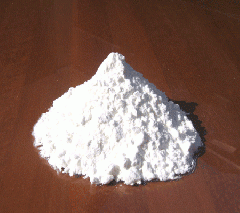Sago Flour
| Infobox on Sago Flour | |
|---|---|
| Example of Sago Flour |  |
| Facts | |
| Origin | See text |
| Stowage factor (in m3/t) | 1,61/1,98 m3/t (bags) |
| Humidity / moisture | - |
| Oil content | - |
| Ventilation | - |
| Risk factors | See text |
Sago Flour
Description
Sago is a starch extracted in the spongy centre, or pith, of various tropical palm stems, especially Metroxylon sagu. It is a major staple food for the lowland peoples of New Guinea and the Moluccas, where it is called saksak, rabia and sagu. A type of flour, called sago flour, is made from sago. The largest supply of sago comes from the East Indies. Large quantities of sago are sent to Europe and North America for cooking purposes. It is traditionally cooked and eaten in various forms, such as rolled into balls, mixed with boiling water to form a paste, or as a pancake. Sago is often produced commercially in the form of "pearls". Sago pearls can be boiled with water or milk and sugar to make a sweet sago pudding. Sago pearls are similar in appearance to tapioca pearls and the two may be used interchangeably in some dishes.
The fruit of palm trees from which the sago is produced is not allowed to ripen fully. The full ripening completes the life cycle of the tree and exhausts the starch centre to produce the seeds. It leaves a hollow shell and causes the tree to die. The palms are cut down when they are about 15 years old, just before they are ready to flower. The stems, which grow to 30 feet (9 metres high), are split out. The starch pith is taken from the stems and ground to powder. A single palm yields about 800 pounds (360 kilograms) of starch. The powder is kneaded in water over a cloth or sieve. It passes into a trough where it settles. After a few washings, the flour is ready to be used in cooking.
Application
Sago from Metroxylon palms is nearly pure carbohydrate and has very little protein, vitamins, or minerals. 100 grams of dry sago typically comprises 94 grams of carbohydrate, 0.2 grams of protein, 0.5 grams of dietary fiber, 10 mg of calcium, 1.2 mg of iron and negligible amounts of fat, carotene, thiamine and ascorbic acid and yields approximately 355 calories. Sago palms are typically found in areas unsuited for other forms of agriculture, so sago cultivation is often the most ecologically appropriate form of land-use and the nutritional deficiencies of the food can often be compensated for with other readily available foods.
Sago starch can be baked (resulting in a product analogous to bread, pancake, or biscuit) or mixed with boiling water to form a paste. It is a main staple of many traditional communities in New Guinea, Borneo, Maluku, South Sulawesi (most known in Luwu Regency) and Sumatra. In Brunei, it is used for making the popular local cuisine called the ambuyat. It is also used commercially in making noodles and white bread. Sago can also be ground into a powder and used as a thickener for other dishes, or used as a dense flour. It can be made into steamed puddings such as sago plum pudding.
Sago starch is also used to treat fibre, making it easier to machine. This process is called sizing and helps to bind the fibre, give it a predictable slip for running on metal, standardise the level of hydration of the fibre and give the textile more body. Most cloth and clothing has been sized; this leaves a residue which is removed in the first wash.
Sago starch is also used as a key material input in the paper, plywood and textile industries and is used to make adhesives, paper, ethanol, high fructose glucose syrup, maltodextrin, cyclodextrin and monosodium glutamate.[citation needed]
Sago starch can be converted further through fermentation for producing biodegradable plastic and ethanol (gasohol). Its residual biomass can similarly be used as a feedstock for the production of power and heat.
Because many traditional people rely on sago as their main food staple and because those supplies of sago are not unlimited, in some areas commercial or industrial harvesting of wild stands of sago can conflict with the food needs of local communities.
Shipment / Storage / Risk factors
Sago flour is usually shipped in bags. Should be stowed away from odorous cargoes and those giving off moisture. Subject to loss in weight, dependent on moisture content before shipping, proper ventilation and heat. Should not be stowed near boilers. If shipped improperly dried may cause rotting of bags. When bags are slightly wetted, this may result in mustiness, which may possibly be removed by drying in warm air. The quality of the commodity is unaffected. Is easily damaged by odours.
See (also) Flour











